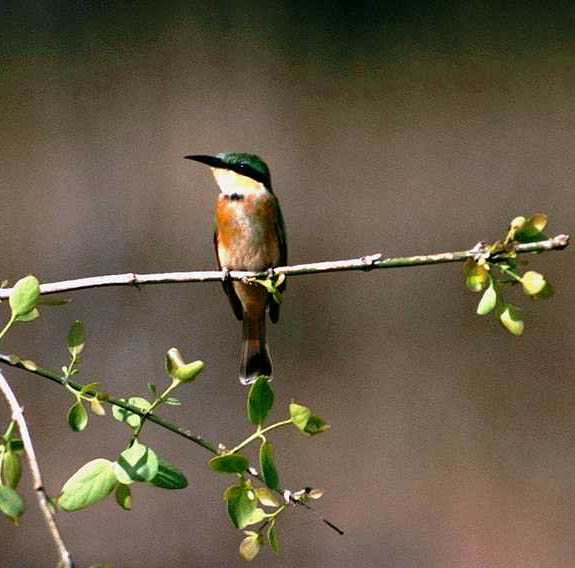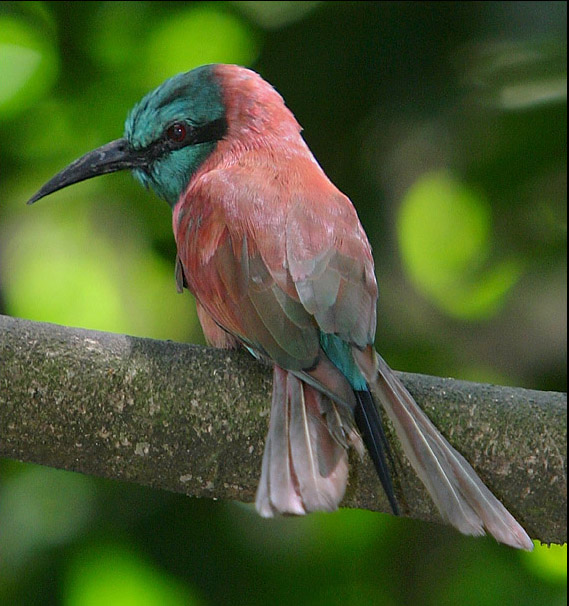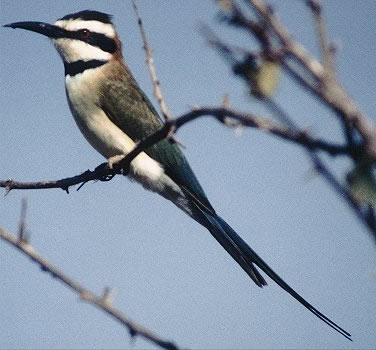|
General Information: The carmine bee-eater regularly utilizes herds of ungulates and bush fires as an aide in the location of food items such as grasshoppers and locusts. In Gambia, the local name for the carmine bee-eater means "cousin to the fire". Description: A large, long-tailed bee-eater measuring approximately 9 1/2 to 10 1/2 inches in body length (not including the tail streamers, which are approximatley 4 1/2 inches in length). The feathering is a combination of bright crimson and carmine over most of the body with a greenish-blue crown. The throat and chin are greenish-blue in the subspecies M.n.nubicus and pink in the subspecies M.n.nubicoides. The trunk, wings, and tail are crimson while the rump and undertail coverts are pale blue. The mask and bill are black. Range: The range of the Carmine bee-eater is divided between Merops n. nubicus and Merops n. nubicoides. The Northern Carmine bee-eater (M.n.nubicus) is found in the northern ranges of the continent including . The Southern Carmine bee-eater (M.n.nubicoides) is found in the southern ranges including . Habitat: Carmine bee-eaters are commonly found in sparsely wooded and bushy savannas, floodplains in the midst of oxbows, cultivated regions, dry grassy plains, coastal mangroves, and lakeshores. Their primary nesting habitat consists of high-banked, fresh-cut sandy cliffs that are almost completely free of vegetation. Typically, this type of habitat is carved out by large river systems winding through habitat. Status: Although the exact population would be difficult to estimate due to the relocation of nest cliffs in subsequent years, estimates are that approximately 10% of the nesting colonies in Africa are known (totalling 130 colonies). Each colony ranges in size from 100 to 1,000 nests and occasionally up to 10,000 nests. From this data, a total population of approximately 5 million carmine bee-eaters would be a possibility (Fry 1984). Diet: The opportunistic nature of the Carmine bee-eater means that it will take advantage of any flying insect available as a food source, often times travelling extensive distances to exploit any plentiful flying insect. The prey items can include locusts, grasshoppers, flying ants, honeybees, termites, cicadas, shieldbugs, dragonflies, butterflies, and even rarely fish gleaned from the water surface. Bee-eaters have learned to take advantage of a variety of species and events to obtain food items. They will utilize large mammals (both domestic and wild), ground birds (such as ostrich, bustard, and storks), that stir up insects during their travels. They will also keep pace with cars, trucks, and tractors in order to prey on insects disturbed by the machinery. A large column of smoke will draw flocks of bee-eaters to the fire in order to hawk in and out of the smoke in pursuit of insects. Breeding: Carmine bee-eaters nest in large, densely packed colonies of excavated tunnels in sandy cliff faces. There are rare incidences of tunnels being dug in level ground. Colonies of bee-eaters may consist of only a few nesting burrows, however it is much more likely that the colony will consist of hundreds, and even thousands, of nesting tunnels. The tunnels are closely grouped together, with nesting cavities being dug at a density of up to 60 tunnels per square meter of cliff face. The same nesting site may be utilized for a series of consecutive years, or the colony may shift the entire nesting to a new point in the river bed depending on the condition of the cliff face. In some areas, the nesting tunnels may be excavated up to four to five months prior to the onset of the laying season. The tunnels are horizontal and straight, typically ranging from one to two meters in length (though records of almost four meters have been observed). The entrance to the tunnel measures approximately six centimeters across. The clutch of eggs varies based on the geographic location. The birds in the higher latitudes will lay a clutch of 3-5 eggs in February through June, while the birds in the southern tropics will lay a clutch of 2-3 eggs in September through November. Captive Breeding: Carmine Bee-eater Nestling Development Gallery Carmine Bee-eater Nestling Weight Gain Records - Captive Parent-reared Chicks Disney's Animal Kingdom Northern Carmine Bee-eater Nesting System Gallery Carmine Bee-eater Gallery
|
||
|
General Information:
Description: A monomorphic species of bee-eater showing a white forehead, throat, chin, belly, and a broad superciliary stripe. The crown, lores, gorget, and ear coverts are black. Primary and secondary wing feathers are buffy in color, while the coverts and scapulars are blue-green or gold-green, fading to greyish-blue on the tertials. The underwing coverts are buff in color, while the undertail coverts are pale blue. The bill is black, the eye is red, and the legs and feet are light brown. The juveniles differ from adult birds primarily by having a pale yellow chin and throat, a black and olive-green head, and a brownish eye color. On newly fledged or very young birds the central tail feathers are shorter than the remainder of the tail feathers. Range: The breeding range of the white-throated bee-eater is a narrow belt of habitat across Africa and the Red Sea. Habitat: During breeding season, the habitat is sparsely wooded sub-desert steppe, arid thorn scrub, and sandy dunes chiefly devoid of vegetation. After the conclusion of breeding season, these bee-eater migrate into the interior of rainforests hawking for food from the canopy. During the course of migration they can be found in essentially any habitat and range up to 3000 meters in elevation, though they primarily remain below 1400 meters and spend the majority of the migration in bushy savanna habitat. Status:
Diet: Typical of most bee-eaters, the chief diet item for the white-throated bee-eater is flying insects, especially flying ants. The diet will also include various hymenopterans, beetles, grasshoppers, flies, dragonflies, butterflies, termites, and lacewings. Infrequently, additional items such as ant-lion larvae and skinks may be taken as prey items. In addition to these hunted prey items, the white-throated bee-eater will regularly perch in the lower canopy of an oil-palm tree waiting for the squirrels to discard the thin strips of oil-palm skin from the fruit, which are caught from mid-air and consumed. Breeding: Burrows are dug into bare sandy ground in loose-knit colonies numbering up to 250 pairs. The nest tunnels are packed at a density of no more than eight nests per hectare. The pairs are primarily monogamous and nearly all pairs have nest helpers numbering up to five helpers per pair - much higher numbers than in any other bee-eater species. The nest tunnels are straight and measure approximately 1-2 meters in length, declining at an angle of 20-24% resulting in an egg chamber located 40-60cm below the level of the entrance to the tunnel. Once completed, the nest structure will hold a clutch of 6-7 eggs measuring .These eggs will be incubated for days prior to the hatching. During their growth, the chicks are fed by both parents, and by all of the nest helpers. After days have elapsed, the bee-eaters will fledge from the tunnel. White-throated Bee-eater Gallery
|
||

Little Bee-eater General Information:
Description:
Range:
Habitat:
Status:
Diet:
Breeding:
Little Bee-eater Gallery
|
||
|
European Bee-eater (Merops apiaster) General Information:
Description:
Range:
Habitat:
Status:
Diet:
Breeding:
Little Bee-eater Gallery
|
 Carmine
Bee-eater (Merops nubicus)
Carmine
Bee-eater (Merops nubicus)  White-throated
Bee-eater (Merops albicollis)
White-throated
Bee-eater (Merops albicollis)